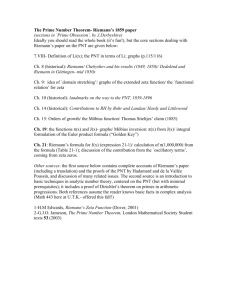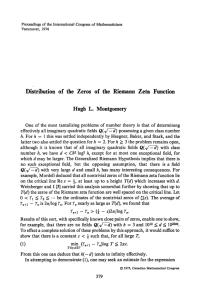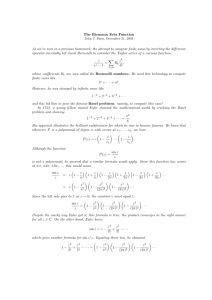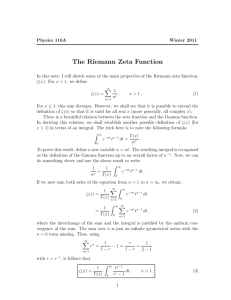a basic calculus approach to estimating the zeros of the riemann
advertisement
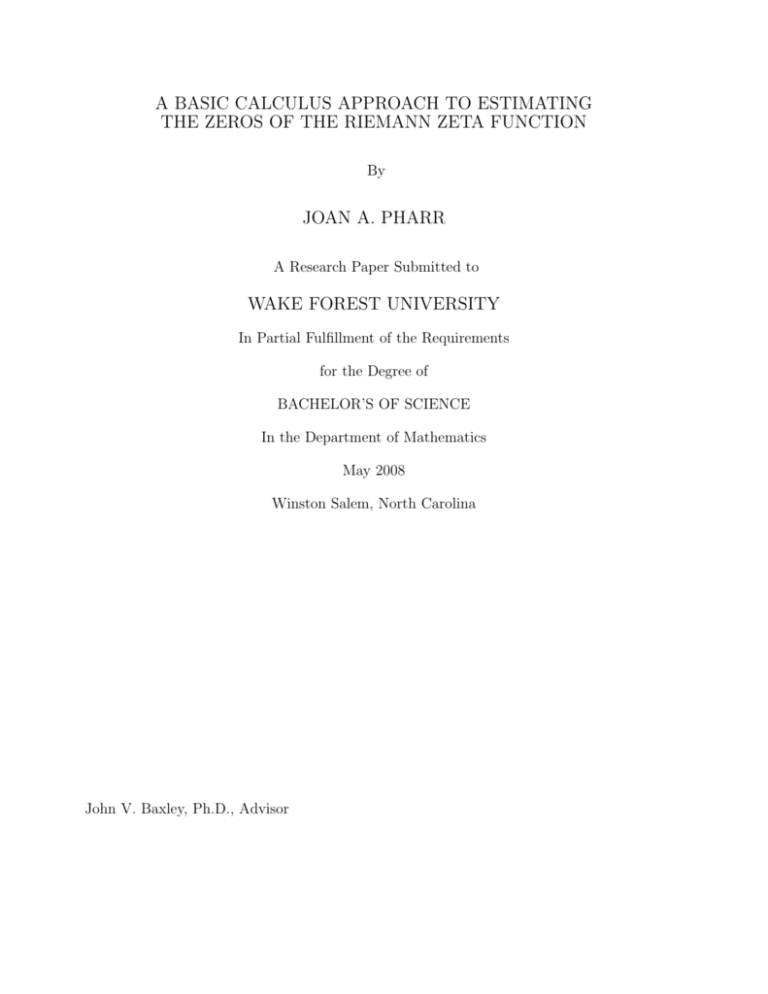
A BASIC CALCULUS APPROACH TO ESTIMATING THE ZEROS OF THE RIEMANN ZETA FUNCTION By JOAN A. PHARR A Research Paper Submitted to WAKE FOREST UNIVERSITY In Partial Fulfillment of the Requirements for the Degree of BACHELOR’S OF SCIENCE In the Department of Mathematics May 2008 Winston Salem, North Carolina John V. Baxley, Ph.D., Advisor Abstract Joan A. Pharr A BASIC CALCULUS APPROACH TO ESTIMATING THE ZEROS OF THE RIEMANN ZETA FUNCTION Research under the direction of John V. Baxley, Ph.D., Professor of Mathematics. Let p be a complex number with Re(p)= 1 2 ζ(p) = ∞ X 1 p k=1 k We are interested in enlarging the domain of this function and finding an approximation for the value of its zeros using methods familiar to students of basic calculus. 1 The Zeta Function To define the Riemann Zeta function we begin with the p-series from calculus. This P 1 is the series ∞ k=1 kp , which converges for p > 1. The most common way to verify this convergence is to use the integral test. For our definition we will need to consider complex values of p = r + it. For such p we can use Euler’s definition of eiθ = cos θ + i sin θ and thus k −p = e−(r+it) ln(k) = e−r ln(k) e−it ln(k) . Then we simplify 1 1 = r [cos(t ln(k)) − i sin(t ln(k))]. p k k Giving us | k1p | = k1r so we see that the p-series for a complex p converges absolutely for r = Re(p) > 1. Real series which converge absolutely are also convergent. This is valid for complex series as well. Therefore the p-series converges in the right half plane Re(p) > 1. The sum of this series defines the Riemann Zeta Function, ζ(p), for such values of p. Riemann’s Hypothesis This Zeta function is the key feature of Riemann’s Hypothesis. Riemann (1859) used complex analysis to extend the domain of ζ(p) to include all complex numbers, with the exception of p = 1. This extended function has real zeros at each negative even integer. These are called the trivial zeros of the Zeta function. Riemann realized that there were many other zeros, all non-real, and showed that they were located in the critical strip, 0 ≤ Re(p) ≤ 1. Based on empirical evidence, Riemann conjectured that all these zeros actually satisfy Re(p) = 12 , and called this line the critical line. To this day the conjecture has yet to be proven theoretically, although there is now a wealth of computations supporting his hypothesis. Riemann stated he had given some “vain, fleeting attempts” to verify his conjecture, but put these efforts aside because it was not necessary for his goal of understanding the distribution of prime numbers. In 1896 his ideas were used to prove the prime number theorem, separately and simultaneously by Jacques Hadamard and Charles de la Vallee Poussin, which only depended on knowing that all the non-trivial zeros have Re(p) < 1. Enlarging the domain of the Zeta Function There are many ways to enlarge the domain of the Riemann Zeta function. We are interested in the zeros which lie within the critical strip. Therefore it is necessary only to enlarge the domain to include the critical strip, 0 ≤ Re(p) ≤ 1. We must ensure that after enlarging the domain we still have the same function. Luckily, thanks to a wonderful theorem in complex analysis, there is only one way to extend the function if we insist on keeping the extended function differentiable, i.e. analytic. If our extended function is analytic we can be sure that it is the same as Riemann’s extension, no matter how different our expression may appear from the original or Riemann’s extension. 2 Using some advanced calculus, we can show that the Zeta function is analytic for Re(p) > 1. We know that if the differentiated series converges uniformly then the sum of the series is differentiable and can be differentiated term-by-term. The differentiated series P − ln(k) ≤ ln(k) . If > 0 and r = Re(p) ≥ 1 + , then ln(k) ≡ Mk . for the zeta function is ∞ k=1 kp |kp | k1+ P∞ Since k=1 Mk converges by the ratio test, then by the Weierstrass M-test, our differentiated series converges uniformly for r = Re(p) ≥ 1 + , for any > 0. A very easy way to enlarge the domain is by changing the p-series to the alternating series ∞ X (−1)k+1 A(p) = . kp k=1 By the alternating series test we know that this series converges when p > 0. This result also holds for complex p for Re(p) > 0, thus includes the critical strip in the interval of convergence. Considering Re(p) > 1 we see ζ(p) − A(p) = 2 1 1 1 + + + ... 2p 4p 6p Which can be simplified to ζ(p) − A(p) = and thus ζ(p) = 1 2p−1 ζ(p) A(p) 1 1 − 2p−1 This method was first developed by Euler, but it converges exceedingly slowly because the rate of convergence is that of the first term omitted. The error is really high. Adding up over 10,000 terms yields only two decimal places of accuracy, making it a relatively ineffective method for computation. Since absolute convergence is not true in the critical strip and the Weierstrass M-test cannot be used, it is not obvious that A(p) is differentiable for Re(p) > 0. Our method described below is not nearly as effective as the Riemann-Seigel formula. Although it lacks in sophistication, only knowledge of elementary calculus and some complex numbers is needed for the explanation. To enlarge the domain we will use Taylor’s formula from calculus. This method was first used by Dr. Baxley to enlarge a domain for computational purposes in a December, 1992, Mathematics Magazine article on Euler’s Constant, Taylor’s Formula and Slowly Converging Series. This method via Taylor’s formula is effective for computation, if the Im(ζ(p)) is not too large. It seems to be roughly as effective as a well-known method using the Euler-Maclaurin summation formula, which we will not describe here. Keeping f (x) = x1p in mind, Taylor’s formula provides us with f (x, p) = f (k, p) + f 0 (k, p)(x − k) + · · · + f (n) (k, p) (x − k)n + Rn (x, k), n! (1) where k is a positive integer. Note our function depends on p as well, the reasoning behind this will be explained shortly. Since our f (x) is complex for real x, we must be careful 3 about the value of the remainder term Rn (x, k). Writing f (x, p) = g(x, p) + ih(x, p), with g(x, p) and h(x, p) real, we can write down the Taylor formula for g(x, p) and also for h(x, p). Multiplying the formula for h(x, p) by i and adding we get Rn (x, k) = g (n+1) (c, p) + ih(n+1) (d, p) (x − k)n+1 (n + 1)! for some numbers c and d between k and x. Thus q |Rn (x, k)| = ((g (n+1) (c, p))2 + (h(n+1) (d, p))2 ) |x − k|n+1 (n + 1)! Remember for any complex number z = a + ib, we have |a| ≤ |b| ≤ q q (a2 + b2 ) = |z| and (a2 + b2 ) = |z|. Therefore q |Rn (x, k)| ≤ |f (n+1) (c)|2 + |f (n+1) (d)|2 ) |x − k|n+1 (n + 1)! Now letting Mn (f, k, x) be the maximum value of |f n+1 (t)| for all t between k and x, we have q ((Mn (f, k, x))2 + ((Mn (f, k, x))2 ) |Rn (x, k)| = |x − k|n+1 (n + 1)! √ 2Mn (f, k, x) |x − k|n+1 . = (n + 1)! Equation (1) along with the above bound is a statement of Taylor’s theorem for such complex valued functions with a real variable x. Equation (1) is derived with p held constant and all derivatives are with respect to x. For our function f (x, p) = x−p , one can check that f (x, p), f 0 (x, p), ..., f (n) (x, p) are all differentiable, hence analytic, with respect to p and with x held constant. The resulting expression when solving for Rn (x, p) is clearly an analytic function of p. Furthermore this shows that the expression we get for the Zeta function after using Taylor’s formula is analytic in the critical strip excluding p = 1. Using n = 1 in (1) and integrating from k − .5 to k + .5 gives us Z k+.5 k−.5 f (x)dx = f (k) + Ck , where Ck = Z k+.5 k−.5 (2) R1 (x, k)dx. Since |f 00 (x)| = |p(p − 1)xp−2 | = |p(p − 1)|xr−2 is decreasing for 0 ≤ r ≤ 1, it is straightforward to verify that √ Z k+.5 √ 00 2 00 |Ck | ≤ 2|f (k − .5)| (x − k)2 dx ≤ |f (k − .5)|. 24 k 4 Summing (2) from n + 1 to ∞ (for Re(p) > 1) gives Z ∞ ∞ X f (x)dx = n+.5 f (k) + En (3) k=n+1 where √ √ Z √ ∞ 2 X 2 ∞ 00 2|p(p + 1)| 00 |En | ≤ |f (k − .5)| ≤ |f (x − .5)|dx ≤ . 24 k=n+1 24 n 36(n − .5)Re(p)+1 Performing the integration in (3) with f (x) = x−p and replacing the sum in (3) by ζ(p) − Pn 1 k=1 kp , we then solve for ζ(p) and get the 1st Taylor’s approximation ζ(p) = n X 1 (n + .5)1−p − − En p 1−p k=1 k (4) This expansion yields an effective approximation for zeros when the Im(p) was not large. We will provide some computational results later. We increased the number of terms in Taylor’s formula with the hope of increasing accuracy. Returning to Taylor’s formula (1) with n = 3, integrating from k − .5 to k + .5, we get Z k+.5 f 00 (k, p) + Dk f (x, p) = f (k, p) + 24 k−.5 where Dk = R k+.5 k−.5 R3 (k, p). Summing from n + 1 to ∞, we get ∞ X Z ∞ 1 f (k) + f (x)dx = 24 n+.5 k=n+1 Z ∞ n+.5 00 f (x)dx − En00 + En0 , where we have used Equation (3), applied to f 00 (x) rather than f (x) and used the approximation for En above for the second derivative, while En0 is the sum of the Dk ’s. Note that |f (4) (x)| is decreasing and the required convergence occurs for f (x) = x1p , with Re(p) > 1. R∞ 1 1 Thus we substitute f (x) = xp starting with n+.5 xp dx and Re(p) > 1 to obtain the 3rd Taylor’s approximation − ∞ X (n + .5)1−p 1 p = + + Qn p 1−p 24(n + .5)p+1 k=n+1 k After substitution and some rearranging we have ζ(p) = − where n (n + .5)1−p X 1 p + − − Qn p 1−p 24(n + .5)p+1 k=1 k √ 13 2|p(p + 1)(p + 2)(p + 3)| |Qn | ≤ . 5760(−Re(p) − 3)(n − .5)Re(p)+3 5 (5) For real values p the calculus student will find the above calculations familiar. Fortunately, the calculations remain valid for complex p. Note that all terms on the right side of (5) are analytic if Re(p) > −3 and p 6= 1. Thus we can extend ζ(p) using (3) to include the critical strip. Computing ζ(p) on the Critical Line 1 Remember how we defined the zeta function earlier: ζ(p) = ∞ k=1 kp which can be Pn P 1 broken into ζ(p) = k=1 k1p + ∞ k=n+1 kp . By rearranging for the sum found in (5) and solving for ζ(p), we now have an approximation for the Zeta function. To find the value of ζ(1/2) using the 3rd Taylor’s approximation we substitute p = .5 P ζ(1/2) ≈ √ 1 1 √ − 2 n + .5 − . 48(n + .5)3/2 k k=1 n X According to Edwards’ book on Riemann’s Zeta Function, the correct value of ζ(1/2) to six decimal places is 1.46035496; our approximation differs from the correct value by less than five in the seventh decimal place. With p = .5 our error estimate yields √ 39 2 . |Qn | ≤ 9200(n − .5)7/2 For n = 10, we have error less than 1.725461240 ∗ 10−7 ; for n = 17, we have error less than 2.498872064 ∗ 10−8 . This appears to indicate that to increase our accuracy we only need to increase n. However, as the imaginary part of .5 + it gets larger, the error estimate for Qn grows rapidly. For example, for t ≈ 50 our error estimate yields roughly √ 13 2(50)4 . |Qn | ≤ 1560(3.5)(n − .5)7/2 For n = 50, 100, 200, 500, we get Qn ≤ .0067, .00058, .000051, .0000020. As p moves further up the critical line, it becomes necessary that n becomes uncomfortably large. This can be partially mitigated by taking more terms in Taylor’s formula. Attempting to attain greater accuracy we extend using Talor’s 5th approximation formula Z ∞ n+.5 f (x)dx = ∞ X n+1 f (k) − 1 000 1 0 f (n + .5) − f (n + .5) 24 1920 Using f (x) = x−p , f 0 (x) = −px−p+1 , f 00 (x) = p(p + 1)x−p+2 , f 000 (x) = −p(p + 1)(p + 2)x−p+3 , we obtain − n X (n + .5)1−p 1 p p(p + 1)(p + 2) = ζ(p) − + + p p+1 1−p 24(n + .5) 1920(n + .5)p+3 k=1 k 6 Rearranging for ζ(p) ζ(p) = Let p = 1 2 n X 1 p (n + .5)1−p p(p + 1)(p + 2) − − − p p+1 1−p 24(n + .5) 1920(n + .5)p+3 k=1 k + it, thus n X .5 + it (n + .5).5−it − .5+it .5 − it 24(n + .5)1.5+it k=1 k (.5 + it)(1.5 + it)(2.5 + it) − 1920(n + .5)3.5+it ζ(.5 + it) = 1 − k −it = e−it ln(k) = cos(t ln(k)) − i sin(t ln(k)) The third Taylor’s doubling “ n” results in an additional decimal place of accuracy. However, lengthening the terms in Taylor’s formula is not enough. The “n” in the denominator does aid in sharpening the estimate, but the additional “p” terms in the numerator quickly detract from this improvement as the Re(p) increases. Consider the case were p = .5 + i50. Clearly, ours is not the best method to compute ζ(p) for values far up the critical line. The experience here is similar to that using the Euler-Maclaurin summation formula. Serious computations require much more sophisticated methods. In this light, the Riemann-Siegel formula is all the more impressive. 7 References [1] John V. Baxley,(1992) Euler’s Constant, Taylor’s Formula and Slowly Converging Series Mathematics Magazine 65.5. 302–313. [2] John Derbyshire Prime Obsession 2003: Joseph Henry Press, Washington, D.C.. [3] Harold M. Edwards Riemann’s Zeta Function 1974: Dover Publications, INC., Mineola, New York. 8





